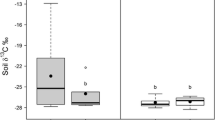Summary
Burrow formation (burrow length and faeces production) of the substrate feeding earthworm Aporrectodea caliginosa (Savigny) in relation to three temperatures (5, 10 and 15°C) and soil moisture contents (48, 60 and 73% water of dry wt) was determined. Soil moisture content affected the burrowing activity of A. caliginosa only below a distinct threshold (60% water of dry wt). At sufficient moisture an, increase in temperature by 5° C approximately doubled the amount of egesta produced. Another substrate feeding earthworm (Octolasion lacteum (Örley)) showed a similar pattern of burrowing activity.
The data for the dependence of the faeces production of A. caliginosa on soil temperature and moisture content were combined with field data. The amount of faeces produced by the population of this earthworm species in a beechwood on limestone was calculated to be about 4.23 kg ha-1 a-1. The amount of egesta produced by all substrate feeding species is assumed to exceed 6 kg ha-1 a-1, which is equivalent to a soil layer of approximately 9 mm. This group of earthworms is therefore considered to be of greater importance for bioturbation and the formation of mull than previously assumed.
Similar content being viewed by others
References
Balzer R (1956) Die Regenwürmer Westfalens. Eine tiergeographische, ökologische und sinnesphysiologische Untersuchung. Zool Jb 84:355–414
Bolton PJ, Phillipson J (1976) Burrowing, feeding, egestion and energy budgets of Allobophora rosea (Savigny) (Lumbricidae). Oecologia (Berlin) 23:226–245
Bornebusch CH (1930) The fauna of forest soils. Forst Forsøgsv Danm 11:1–224
Bouché MB (1977) Strategie lombriciennes. In: Lohm U Persson T (eds) Soil organisms as components of ecosystems. Ecol Bull 25, Stockholm, pp 122–132
Crossley DA, Reichle DE, Edwards CA (1971) Intake and turnover of radioactive cesium by earthworms (Lumbricidae). Pedobiologia 11:71–76
Edwards CA, Lofty JR (1977) Biology of earthworms, 2nd ed. Chapman and Hall, London
Evans AC (1947) A method for studying the burrowing activities of earthworms. Ann Mag nat Hist 14:643
Evans AC (1948) Some effects of earthworms on soil structure. Ann appl Biol 35:1–13
Hartenstein R, Amico L (1983) Production and carrying capacity for the earthworm Lumbricus terrestris in culture. Soil Biol Biochem 15:51–54
Lamparski F, Zöttl HW (1981) Der Regenwurm Lumbricus badensis als bodenprägender Faktor im Südschwarzwald. Mitt Dtsch Bodenkundl Ges: 499–508
Lindquist B (1938) Dalby Söderskog: en skansk lövskog i forntid och nitid, Stockholm, pp 1–273
Martin NA (1982) The interaction between organic matter in the soil and the burrowing activity of three species of earthworms (Oligochaeta: Lumbricidae). Pedobiologia 24:185–190
Nordström S, Rundgren S (1974) Environmental factors and lumbricid associations in southern Sweden. Pedobiologia 14:1–27
Parle JN (1963) Micro-organisms in the intestine of earthworms. J Gen Microbiol 31:1–11
Phillipson J, Abel R, Steel J, Woodell SRJ (1978) Earthworm numbers, biomass and respiratory metabolism in a beech woodland — Watham Woods, Oxford. Oecologia (Berlin) 33:291–309
Raw F (1962) Studies of earthworm populations in orchards. 1. Leaf burial in apple orchards. Ann Appl Biol 50:389–404
Satchell JE (1967) Lumbricidae. In: Burges A, Raw F (eds) Soil biology. Academic Press, London, pp 259–322
Stockdill SMJ (1982) Effects of introduced earthworms on the productivity of New Zealand pastures. Pedobiologia 24:29–35
Ulrich B, Mayer R, Beese F, Meiwes J (1982) Stofflüsse und —Haushalt. Arbeisberichte aus dem SFB 135 (1):299–327
Wittich W (1963) Die Bedeutung einer effektiven Regenwurmpopulalgemeine Bodenumsätze. Schriftenreihe der Forstlichen Fakultät der Universität Göttingen 30:3–60
Zicsi A (1975) Zotische Einflüsse auf die Streuzersetzung in Hainbuchen-Eichenwäldern Ungarns. Pedobiologia 15:432–438
Author information
Authors and Affiliations
Rights and permissions
About this article
Cite this article
Scheu, S. The role of substrate feeding earthworms (Lumbricidae) for bioturbation in a beechwood soil. Oecologia 72, 192–196 (1987). https://doi.org/10.1007/BF00379266
Received:
Issue Date:
DOI: https://doi.org/10.1007/BF00379266




